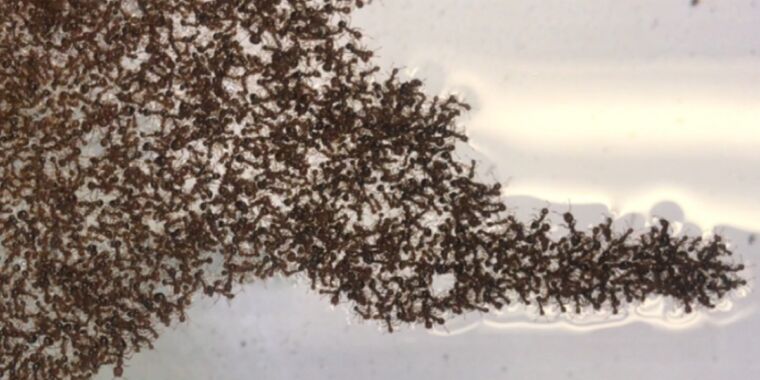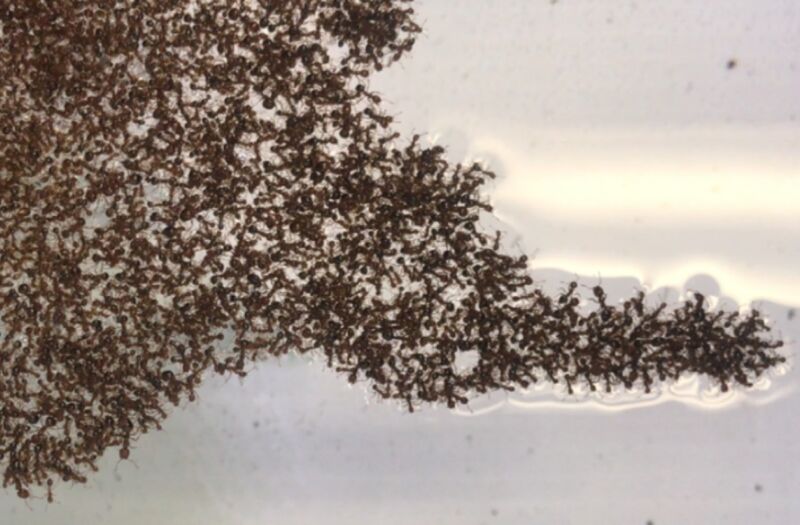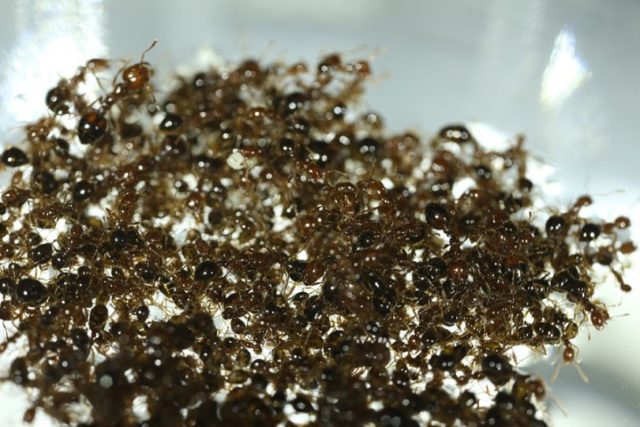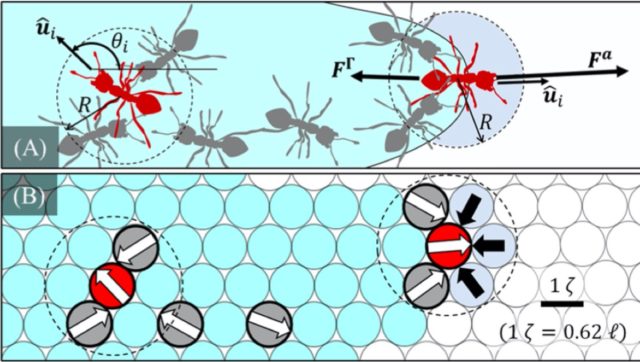

Vernerey Research Group/CU Boulder
Fire ants are a textbook example of collective behavior, capable of behaving as individuals, and also banding together to form floating rafts in response to flooding. Now a pair of mechanical engineers from the University of Colorado, Boulder, have identified some simple rules that seem to govern how floating rafts of fire ants contract and expand their shape over time, according to a new paper published in the journal PLOS Computational Biology. The hope is that by gaining a better understanding of the simple rules underlying fire ant behavior, they can develop better algorithms controlling how swarms of robots interact.
It’s not a matter of brain power or careful planning. “This behavior could, essentially, occur spontaneously,” said co-author Robert Wagner. “There doesn’t necessarily need to be any central decision-making by the ants.” Indeed, “Single ants are not as smart as one may think, but, collectively, they become very intelligent and resilient communities,” said co-author Franck Vernerey.
As we’ve reported previously, a few ants spaced well apart behave like individual ants. But pack enough of them closely together, and they behave more like a single unit, exhibiting both solid and liquid properties. They can form rafts or towers, and you can even pour them from a teapot like a fluid. Fire ants also excel at regulating their own traffic flow.
Any single ant has a certain amount of hydrophobia—the ability to repel water—and this property is intensified when they link together, weaving their bodies much like a waterproof fabric. They gather up any eggs, make their way to the surface via their tunnels in the nest, and as the flood waters rise, they’ll chomp down on each other’s bodies with their mandibles and claws, until a flat raft-like structure forms, with each ant behaving like an individual molecule in a material—say, grains of sand in a sand pile.
The ants can accomplish this in less than 100 seconds. Plus, the ant-raft is “self-healing”: it’s robust enough that if it loses an ant here and there, the overall structure can stay stable and intact, even for months at a time. In short, the ant raft is a super-organism.
In 2019, researchers at Georgia Tech demonstrated that fire ants can actively sense changes in forces acting upon the raft under different fluid conditions and adapt their behavior accordingly to preserve the raft’s stability. For instance, with a shearing force, the area of the raft was much smaller than when the ants encountered just centrifugal force. Ants experience the latter regardless of where they are positioned in the ant raft, whereas only the ants at the boundary experience the strongest shearing force. The scientists hypothesized that the smaller rafts are the result of ants trying to avoid being at the boundaries, minimizing the surface area in the process.

Hungtang Ko
The Georgia Tech team also noted that fire ants in a raft explore more if the raft is stationary—usually spreading out horizontally, but also vertically, building temporary tower-like structures in hopes of finding a hanging branch to grab onto to get back to dry land. There will be a lot less exploratory behavior if the ant raft is spinning in response to centrifugal or shear forces.
Vernerey and Wagner’s new research builds on a study they published last year. They conducted experiments by dropping hordes of fire ants into a bucket of water with a plastic vertical rod in the middle, and then monitored the ants’ raft-building behavior over the next eight hours. The idea was to observe how the rafts evolved over time. They noticed that the rafts didn’t stay the same shape. Sometimes the structures would compress into dense circles of ants. Other times, the ants would start to fan out to form bridge-like extensions, sometimes using them to escape the containers, suggesting that the behavior might serve an evolutionary advantage.
The duo was fascinated by how the ants achieved those changes in shape through a process they dubbed “treadmilling.” The rafts essentially are comprised of two distinct layers. Ants on the bottom layer serve a structural purpose, making up the stable base of the raft. But the ants on the upper layer move freely on top of the linked bodies of their bottom-layer brethren. Sometimes ants move from the bottom to the upper layer, or from the upper to the bottom layer in a cycle that Wagner calls “a doughnut-shaped treadmill.”

Wagner & Vernerey, 2022
Vernerey and Wagner wanted to determine whether this treadmilling behavior was a deliberate decision by the ants, or whether it emerged spontaneously. So they created a series of agent-based models consisting of 2000 particles (“agents) representing each individual ant, confined to a lattice of water nodes. One population of agent-ants (shown in cyan) made up the structural base network; the other agent-ants (shown in red) were free to move on top of them.
The ants were programmed to follow a simple set of rules, such as avoiding collisions with other ants, and not falling into water (the “rule of edge deposition”). Then they let the simulations play out. And the simulated ants behaved much like their real-world counterparts.
For instance, when active agent-ants reached the edge of the raft and came into contact with water, they avoided moving into the water unless forced to do so by neighboring active agent-ants—and then only if there were enough structural-supporting ants to grab onto. The simulations also showed bridge-like protrusions forming spontaneously, and the researchers were able to link those formations with the relative activity of the ants. The more active the ants were, the more likely it was that protrusions would start to form.
“The ants at the tips of these protrusions almost get pushed off of the edge into the water, which leads to a runaway effect,” said Wagner. It’s possible these protrusions are a way for the fire ants on a raft to probe their environment, perhaps searching for a log or dry land.
“While cueing factors such as pheromones have not been ruled out and should be tested for in future experimental studies, this model generally poses local mechanisms through which fire ants may achieve treadmilling and protrusion growth without centralized control or purposeful intent,” the authors concluded. That said, they acknowledge that this is a homogenized model, and that there is likely to be more than one set of rules governing the treadmilling behavior and emergence of protrusions—another future focus of their research.
DOI: PLOS Computational Biology, 2022. 10.1371/journal.pcbi.1009869 (About DOIs).